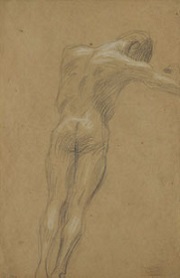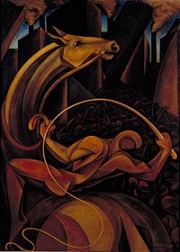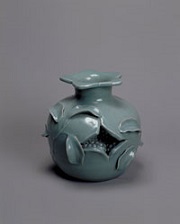Collection GalleryThe 3rd Collection Gallery Exhibition 2016–2017 (155 works in all)
Collection Gallery
HOME > Collection Gallery > The 3rd Collection Gallery Exhibition 2016–2017
The 3rd Collection Gallery Exhibition 2016–2017 (155 works in all)
Exhibition Period
7. 27 (Wed.) – 9.19 (Mon. National Holiday), 2016
Overview
The third collection gallery exhibition of this year features “Curatorial Studies” and exhibits related to the special exhibition entitled “A Feverish Era: Art Informel and the Expansion of Japanese Artistic Expression in the 1950s and ‘60s,” being held simultaneously at the Special Exhibition Gallery, with the introduction of our new collection pieces, which were acquired last year.
Last year, a new collection entitled “The Graphics of Wiener Moderne” was added to our museum. It is comprised of 300 works including magazines, books, illustrations, prints and others, which are considered a precious group of visual culture that was popular in Vienna from the 1890s to the 1910s. Even though the entire collection is planned to be open to the public between 2018 and 2019, a part of it, such as drawings and prints by Gustav Klimt, Oskar Kokoschka and Egon Schiele, is being displayed on this occasion. In particular, most of Klimt’s drawings are sketches for the series entitled “Ceiling Paintings with the Themes of Philosophy, Medicine and Jurisprudence” (a.k.a. “the Faculty Paintings”), created for the University of Vienna’s Great Hall. The university eventually decided not to accept these paintings and not to install them at the Great Hall owing to their distinctive characteristics. Even though they attracted the public’s attention during the “Wiener Secession Exhibitions” and “Paris World Exposition” in 1900, they were unfortunately destroyed by fire during World War Ⅱ. Because of this, many sketches which remain today have become precious resources for the study of the meaning of those mysterious paintings.

- Gustav KLIMT, Hovering Male Nude from the Back to the Right
(Study for the Faculty Painting "Philosophy" for the Ceilling of the University of Vienna’s Great Hall)
1897-99
The Japanese-style painting (Nihon-ga) section features diverse creation of Nihon-ga painters whose works are being introduced at the special exhibition, “A Feverish Era: Art Informel and the Expansion of Japanese Artistic Expression in the 1950s and ‘60s.” For example, works by Domoto Hisao, who played an active role in Paris, and those by the painters who belonged to Pan Real Art Association, such as Fudo Shigeya, Ono Hidetaka, and Nomura Ko, and works of Domoto Insho, who made a dramatic transition from being a traditional Shijo school artist to becoming an abstract painter, are particularly worthy of note.
The western-style painting section features the paintings of another “Feverish Era,” i.e., the paintings from the Taisho period. The painters during this period struggled to create their own style of paintings, by utilizing oil painting techniques they had learned from the West. At the same time, they tried to greedily absorb the new art trends in the West, such as cubism and fauvism, as represented by Ishigaki Eitaro’s “Whipping” and Satomi Katsuzo’s “Spring in a Valley.”

- ISHIGAKI, Eitaro, Whipping, 1925
The photography section focuses on the “MINAMATA” series by W. Eugene Smith, a member of the worldwide well-known group of photographers “Magnum Photos”. He stayed in Minamata from 1971 to 1974, in order to capture of the reality of mercury pollution caused by the effluent from Chisso Corporation. The photography, distinguished by a stark contrast between pitch-dark black and immaculate white, was published as a photography collection entitled “MINAMATA” in 1975, and caused a great sensation all over the world. It is our sincere wish that the exhibition will create a special opportunity for everyone to consider the many kinds of unresolved pollution problems, including Minamata disease.
Entitled “A Refreshing Way to Enjoy Summer,” the craft section features textile and glass works which evoke feelings of coolness. In the category of pottery, celadon pottery have been specifically chosen for display from our collection. Pale blue comes in a variety of hues and tones. We hope that these craft works will help alleviate the scorching heat of the hot summer months, and evoke feelings of a cool, summer resort.

- KIYOMIZU, Rokubei Ⅴ,
Flower Vase with Pomegranate Design, celadon glaze,
1930
In the exhibition room with a skylight, “Curatorial Studies 11: Artists around Mannequin Factory NANASAI - Experiments of Art+Design+Crafts in 1946-1980” is being introduced. The “feverish” activities of “Hi no Geijutsu no kai (the Society of Flaming Arts)” were organized by Mukai Ryokichi, who was the established sculptor and the first president of Kyoto-based mannequin manufacturer Nanasai. Starting with the first dramatic mannequin made by Mukai in 1950, a wide variety of historical mannequins are being installed not only inside the exhibition gallery but also in the public spaces for our visitors to enjoy.
Themes of Exhibition
- ・Curatorial Studies 11: Artists around Mannequin Factory NANASAI --- Experiments of Art + Design + Crafts in 1946-1980
- ・Klimt, Schiele and Kokoschka - From New Acquisition
- ・Before / After a Feverish Era in Japanese-style Painting: Spin-off of the Special Exhibition
- ・MINAMATA by W. Eugene Smith and Aileen M. Smith
- ・A Refreshing Way to Enjoy Summer: Modern Glassworks and Textiles
- ・Ceramics of Celadon Blue and Bluish White
- ・Paintings in the Taisho Era (1912–1926)
- ・[Outside] Outdoor Sculptures


